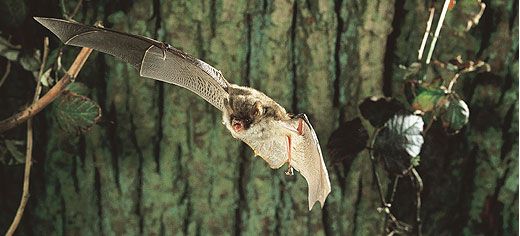
New study suggests major roads significantly reduce bat numbers, activity and diversity - raising serious issues for how road construction projects mitigate their impact on these protected species.
The findings - published today in the Journal of Applied Ecology - show that the negative impact of a major road stretches a considerable distance, with bat activity three times lower at the roadside than 1.6km away. As bats are protected under UK and EU legislation, the research could have legal consequences for road builders.
"UK and European law protects all species, so construction work must not have a negative impact on bat populations," says Professor John Altringham from Leeds' Faculty of Biological Sciences, who led the research. "This study shows that the impact of roads on bats is far-reaching, and road construction projects must take this into account or they are potentially breaking the law."
The study measured bat activity and diversity along unlit sections of the M6 motorway in Cumbria, in the North of England, which carry between 30,000 and 40,000 vehicles a day. PhD student Anna Berthinussen, the lead author of the paper, walked along 20 routes perpendicular to the motorway, stopping at set points along the way, up to 1.6km from the road.
Using ultrasonic detectors to record echolocation calls as bats flew past, she assessed bat foraging activity levels and then analysed the recordings to identify different species groups. The researchers took into account other factors such as the time after sunset, habitat and weather.
Just under 3,500 'bat passes' were recorded and three main groups of bat species identified - Pipistrellus, Myotis and Nyctalus. Activity gradually increased as the researchers got further from the road, with three times as much activity measured at 1.6km relative to at the roadside. Although their numbers declined, Pipistrellus bats were recorded at all locations, but Myotis were mainly seen at further distances from the road.
"The results were really clear cut when all other factors were taken into account, showing a very strong correlation between bat activity and diversity and distance from the road," says Anna. "Bat activity showed no sign of levelling off before the last recorded point, so it's likely that activity would continue to increase beyond the distance set for this study."
Professor Altringham believes the road is acting as a physical barrier to the bats, cutting off colonies from established foraging sites thereby reducing the area and quality of the available habitat. "Most species of bat fly relatively close to the ground, or close to trees and hedges, so they are reluctant to cross a wide open space such as a major road, particularly when it is occupied by heavy, fast moving traffic.
If they do attempt to cross, it is typically at traffic height, with a high risk of collision. Loss of habitat and increased mortality will both lead to population decline." "Most bat species forage up to about three kilometres from their roost.
If a road cuts across their home range, reducing access to part of it, they will struggle to find sufficient food unless the colony relocates away from the road, putting them in competition with other colonies," he says. "If they stay, reduced food supplies will mean less successful breeding.
Either way, it will be some time before the impact on population size is seen, since bats can live for 10-15 years or more and reproduce slowly." "New road schemes often incorporate mitigation for their impact on wildlife, such as the 'bat bridges' or 'bat gantries' recently proposed for the A11 in Suffolk*, which are supposed to make roads safe and more 'permeable'.
Sadly, we have little or no evidence for the effectiveness of these measures. Monitoring standards are poor and mitigation methods are essentially unproven. If we want to have any confidence in the effectiveness of mitigation, such as bridges, underpasses and tree-planting, we need to see major improvements in the quality and application of pre- and post- construction monitoring."
The results are relevant to small insectivorous bats worldwide and highlight the impact of roads on wildlife in general. They also highlight a widespread concern among conservation scientists. "Conservation should be evidence-based," says Professor Altringham. "We need to look more objectively at the impact we have on the natural world, and at the effectiveness of conservation efforts, if we are to make best use of the limited resources conservationists have at their disposal."
* www.bbc.co.uk/news/uk-england-15320603
Image credit: Natterer's bat in flight by Frank Greenaway
Photos are available
For further information:
Please contact the University of Leeds Press Office on +44 (0)113 343 4031 or email pressoffice@leeds.ac.uk
Notes for Editors
The Faculty of Biological Sciences at the University of Leeds is one of the largest in the UK, with over 150 academic staff and over 400 postdoctoral fellows and postgraduate students. The Faculty is ranked 4th in the UK (Nature Journal, 457 (2009) doi :10.1038/457013a) based on results of the 2008 Research Assessment Exercise (RAE). The RAE feedback noted that "virtually all outputs were assessed as being recognized internationally, with many (60%) being internationally excellent or world-leading" in quality. The Faculty's research grant portfolio totals some £60M and funders include charities, research councils, the European Union and industry. http://www.fbs.leeds.ac.uk/
The University of Leeds is one of the largest higher education institutions in the UK with more than 30,000 students from 130 countries. With a turnover approaching £450m, Leeds is one of the top ten research universities in the UK, and a member of the Russell Group of research-intensive universities. It was placed 80th in the 2007 Times Higher Education world universities league table. The University's vision is to secure a place among the world's top 50 by 2015. www.leeds.ac.ukJournal of Applied Ecology is published by Wiley-Blackwell for the British Ecological Society. Contents lists are available at http://www.journalofappliedecology.org/